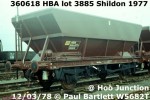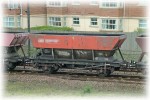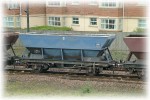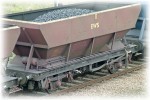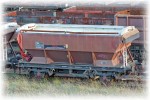 |
Log-in Register Register |
|||||||||||
| RAIL DATA | ||||||||||||

| Title: | HBA/HEA General-Purpose Hoppers |  |
| Built: | 1975-1979 | |
| Builder: | BR Shildon | |
| Numbering: | 360000-361998 | |
| Running Gear: | ||
| Quantity: | 1999 | |
| Used: | 1975-c.2017 | |
| Icons: |
|
|
| Summary: | Just under 2000 HBAs were built in the 1970s and were intended to become the standard general-purpose hopper wagon. Within a few years they were recoded as HEAs with improved suspension. However, declining traffic has seen the fleet undergo numerous modifications and rebuilds. | |
| Profile: |
While the HAA design fulfilled the role of delivering coal to power stations, an updated design was also required for other coal traffics, to replace the large fleet of unfitted and vacuum-braked minerals and hoppers. This appeared in 1975 when the prototype 32.5 ton HBA (360000) was built at Shildon Works. Fitted with manually operated discharge doors, this type was quite different from the HAA, not least in that the hopper body was painted, initially in Bauxite.
A production order was quickly placed for 2000 wagons to be built at Shildon, although in the event two underframes were diverted to become the MFA prototype scrap metal wagons. Delivery of this batch was completed in 1979, by which time two small changes to the design had been made. The ladders fitted at each end were altered from being centrally mounted to being offset to the left. More significantly, Bruninghaus springs were fitted to later builds, enabling the maximum speed to be increased from 45mph to 60. This modification must have proved successful as a plan was put in place to bring the earlier wagons up to the same standard. The TOPS code of HEA was introduced to distinguish these, with the last 80 or so completed by mid-1985. Two further suspension experiments involved the fitting of modified hangers to at least one wagon (361798), and a Gloucester Floating Pedestal type to another (360285). The former had been converted to an RNA (qv) by 1992 while the latter remained as a HBA but was withdrawn by early 1986. In March of that year, the HEA fleet totalled 1972, accident damage presumably accounting for the remainder.
The HBAs and HEAs could be seen in mixed and short block trains in many parts of the country, often delivering household coal to terminals in urban areas (such as West Drayton and Chessington). Other products carried included rock salt. From 1979 the livery was updated, the top half of the hopper being in Railfreight red and the lower half in grey. The repaint programme was never completed and a few (rather rusty) bauxite wagons could still be seen in the early 2000s.
By the latter half of the 1980s, the traffic that the HBA/HEAs were designed for was in decline, due to the reduction in domestic coal consumption and also the closure of several unviable terminals. New roles for the relatively young fleet of wagons had to be found and an early example was carrying rock salt (for use on roads) to Inverness, while another was scrap metal. For the latter role, the wagons were modified by filling the bottom of the hopper with ballast weights and a flat steel floor, unloading being by electromagnet. Recoded HSA, 119 had been converted by early 1988 and were being used on flows to Sheerness Steel, Corby to Mossend, Manchester to Cardiff and in the Leicester area. A further 126 wagons were modified later in the year.
During 1989 a further conversion for scrap traffic saw the SJA code applied to three HSAs (360040, 360761 and 361486) rebuilt with reinforced box bodies. These were painted red and included a door for sweeping out. As no further wagons were converted it can be assumed these were not a complete success.
Another alternative role that commenced at about the same time was the use of HEAs as barrier wagons for nuclear flask trains. After a few months of use unmodified, a programme was started to remove the bodywork from affected wagons and recode them as RNAs. The first appeared in March 1989, retaining the original hopper support framework with the hole in the floor plated over.
A precursor to larger changes took place in early 1989 when three HEAs (360610, 360810 and 360821) were recoded as MEBs for general mineral traffic. The modifications were limited to the fitting of a solid floor and vacuum pipes. After trials in South Wales these were rapidly reallocated to nuclear barrier duties. A more successful conversion involved the fitting of a new reinforced box body similar to that carried by the SJAs (minus the access doors). These wagons were recoded as MEAs and a contract was awarded to RFS Industries to produce 46 in late 1989. Unlike previous conversions, a new number series starting at 391000 was applied and they entered service carrying coal to Swansea Docks in early 1990. Many further conversions followed as detailed on the MEA page LINK.
The pre-privatisation break-up of Railfreight saw new liveries appearing on the HEA fleet, including Transrail grey, Mainline blue, and EWS maroon.
With conversions to box wagons gathering pace, and other wagons transferred to internal use (including some sold to the National Coal Board), the number of HEAs declined steadily throughout the 1990s. Other conversions undertaken during this time included the fitting of a canvas hopper cover mounted on rollers (44 wagons recoded as CEA in 1996 and used for lime, china clay, sand and seaweed!), and a reduced height hopper for the carriage of charged chrome (1 wagon recoded as HOA in 1998 but later rebodied as a standard HEA). In 1992 one of the MEB wagons that had been recoded RNA was also given a canvas cover and recoded as an MGA Open Mineral Wagon. It was rebuilt as a standard MEA in 1996.
The last conversions to MEAs took place in 2004. By 2007, 122 HEA remained in stock, along with 45 CEAs and one HSA. The RNAs had been made redundant by a relaxation in the rules governing the operation of trains conveying nuclear flasks, but the fate of these wagons is not known.
|
|
| References: |
|
|
| Links: | N.B. Links will open in a new window. Photos of HBA/HEA wagons and conversions on Paul Bartlett's website Photos of HEA wagons on Martyn Read's website Photos of CEA wagons on Martyn Read's website Photos of HEA wagons on Andy Jupe's website Photos of CEA wagons on Andy Jupe's website |
|
| Notes: |
No notes have been left yet. ?There may be some notes posted but which have not yet been approved. |
|
| Data tags: ?Tags are mainly intended to show links to relevant profiles when looking at the detail page for TOPS codes, designs, batches etc. Here they work 'backwards' and will take you to the detail pages. |
TOPS Class/Code: CEA Covhop AB, with roof TOPS Class/Code: HBA (1) 2-axle Mineral Hopper Wagon TOPS Class/Code: HEA Mineral Hopper Wagon TOPS Class/Code: HSA Steel Scrap Open 2-axle TOPS Class/Code: MEA Mineral, ex HEA TOPS Class/Code: MEB Mineral, ex HEA TOPS Class/Code: MGA Mineral, ex HEA with top cover TOPS Class/Code: RNA Barrier wagon (ex HEA) TOPS Class/Code: SJA 2-axle Scrap Steel Box Wagon |
|
| Added on: | 16/12/2007 | |
| Edits: |
This item has not been edited. |
|
